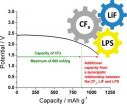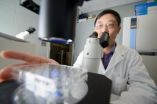(Press-News.org) An international team led by King's College London and the San Francisco Veteran Affairs Medical Center (SFVAMC) has developed the first lab-grown epidermis – the outermost skin layer - with a functional permeability barrier akin to real skin. The new epidermis, grown from human pluripotent stem cells, offers a cost-effective alternative lab model for testing drugs and cosmetics, and could also help to develop new therapies for rare and common skin disorders.
The epidermis, the outermost layer of human skin, forms a protective interface between the body and its external environment, preventing water from escaping and microbes and toxins from entering. Tissue engineers have been unable to grow epidermis with the functional barrier needed for drug testing, and have been further limited in producing an in vitro (lab) model for large-scale drug screening by the number of cells that can be grown from a single skin biopsy sample.
The new study, published in the journal Stem Cell Reports, describes the use of human induced pluripotent stem cells (iPSC) to produce an unlimited supply of pure keratinocytes – the predominant cell type in the outermost layer of skin - that closely match keratinocytes generated from human embryonic stem cells (hESC) and primary keratinocytes from skin biopsies. These keratinocytes were then used to manufacture 3D epidermal equivalents in a high-to-low humidity environment to build a functional permeability barrier, which is essential in protecting the body from losing moisture, and preventing the entry of chemicals, toxins and microbes.
A comparison of epidermal equivalents generated from iPSC, hESC and primary human keratinocytes (skin cells) from skin biopsies showed no significant difference in their structural or functional properties compared with the outermost layer of normal human skin.
Dr Theodora Mauro, leader of the SFVAMC team, says: "The ability to obtain an unlimited number of genetically identical units can be used to study a range of conditions where the skin's barrier is defective due to mutations in genes involved in skin barrier formation, such as ichthyosis (dry, flaky skin) or atopic dermatitis. We can use this model to study how the skin barrier develops normally, how the barrier is impaired in different diseases and how we can stimulate its repair and recovery."
Dr Dusko Ilic, leader of the team at King's College London, says: "Our new method can be used to grow much greater quantities of lab-grown human epidermal equivalents, and thus could be scaled up for commercial testing of drugs and cosmetics. Human epidermal equivalents representing different types of skin could also be grown, depending on the source of the stem cells used, and could thus be tailored to study a range of skin conditions and sensitivities in different populations."
INFORMATION: END
Skin layer grown from human stem cells could replace animals in drug and cosmetics testing
2014-04-24
ELSE PRESS RELEASES FROM THIS DATE:
Scripps Research Institute scientists find new point of attack on HIV for vaccine development
2014-04-24
LA JOLLA, CA— April 24, 2014 —A team led by scientists at The Scripps Research Institute (TSRI) working with the International AIDS Vaccine Initiative (IAVI) has discovered a new vulnerable site on the HIV virus. The newly identified site can be attacked by human antibodies in a way that neutralizes the infectivity of a wide variety of HIV strains.
"HIV has very few known sites of vulnerability, but in this work we've described a new one, and we expect it will be useful in developing a vaccine," said Dennis R. Burton, professor in TSRI's Department of Immunology and Microbial ...
Three-banded panther worm debuts as a new model in the study of regeneration
2014-04-24
CAMBRIDGE, Mass. (April 24, 2014) – Closely resembling plump grains of wild rice set in motion, the three-banded panther worms swimming in disposable containers in Whitehead Institute Member Peter Reddien's lab hardly seem like the next big thing in regeneration. And yet, these little-studied organisms possess the ability to regenerate any part of their bodies and are amenable to molecular studies in the lab, making them a valuable addition to a field keen on understanding how mechanisms controlling regeneration have evolved over millennia and how they might be activated ...
Engineered E. coli produces high levels of D-ribose as described in Industrial Biotechnology journal
2014-04-24
New Rochelle, NY, April 24, 2014—D-ribose is a commercially important sugar used as a sweetener, a nutritional supplement, and as a starting compound for synthesizing riboflavin and several antiviral drugs. Genetic engineering of Escherichia coli to increase the bacteria's ability to produce D-ribose is a critical step toward achieving more efficient industrial-scale production of this valuable chemical, as described in an article in Industrial Biotechnology, a peer-reviewed journal from Mary Ann Liebert, Inc., publishers. The article is available on the Industrial Biotechnology ...
Oxygen diminishes the heart's ability to regenerate, researchers discover
2014-04-24
DALLAS – April 24, 2014 – Scientific research at UT Southwestern Medical Center previously discovered that the newborn animal heart can heal itself completely, whereas the adult heart lacks this ability. New research by the same team today has revealed why the heart loses its incredible regenerative capability in adulthood, and the answer is quite simple – oxygen.
Yes, oxygen. It is well-known that a major function of the heart is to circulate oxygen-rich blood throughout the body. But at the same time, oxygen is a highly reactive, nonmetallic element and oxidizing agent ...
New study helps to explain why breast cancer often spreads to the lung
2014-04-24
New research led by Alison Allan, PhD, a scientist at Western University and the Lawson Health Research Institute, shows why breast cancer often spreads or metastasizes to the lung.
Breast cancer is the number one diagnosed cancer and the number two cause of cancer-related deaths among women in North America. If detected early, traditional chemotherapy and radiation have a high success rate, but once the disease spreads beyond the breast, many conventional treatments fail. In particular, the lung is one of the most common and deadly sites of breast cancer metastasis ...
Parents of severely ill children see benefits as caregivers, says study
2014-04-24
Benefits often coexist with the negative and stressful outcomes for parents who have a child born with or later diagnosed with a life-limiting illness, says a recent study led by a researcher at the University of Waterloo.
While the challenges are numerous and life-changing and stress levels high, the vast majority of parents who participated in the Waterloo-led research reported positive outcomes as well, a phenomenon known as posttraumatic growth. The findings appear in the most recent issue of the American Journal of Orthopsychiatry.
"What is pivotal is the meaning ...
'Double-duty' electrolyte enables new chemistry for longer-lived batteries
2014-04-24
OAK RIDGE, Tenn., April 24, 2014 — Researchers at the Department of Energy's Oak Ridge National Laboratory have developed a new and unconventional battery chemistry aimed at producing batteries that last longer than previously thought possible.
In a study published in the Journal of the American Chemical Society, ORNL researchers challenged a long-held assumption that a battery's three main components -- the positive cathode, negative anode and ion-conducting electrolyte -- can play only one role in the device.
The electrolyte in the team's new battery design has ...
Cell resiliency surprises scientists
2014-04-24
EAST LANSING, Mich. --- New research shows that cells are more resilient in taking care of their DNA than scientists originally thought. Even when missing critical components, cells can adapt and make copies of their DNA in an alternative way.
In a study published in this week's Cell Reports, a team of researchers at Michigan State University showed that cells can grow normally without a crucial component needed to duplicate their DNA.
"Our genetic information is stored in DNA, which has to be continuously monitored for damage and copied for growth," said Kefei Yu, ...
Vanderbilt study finds physical signs of depression common among ICU survivors
2014-04-24
Depression affects more than one out of three survivors of critical illness, according to a Vanderbilt study released in The Lancet Respiratory Medicine, and the majority of patients experience their symptoms physically rather than mentally.
It is one of the largest studies to investigate the mental health and functional outcomes of critical care survivors, according to lead author James Jackson, Psy.D., assistant professor of Medicine, and it highlights a significant public health issue, with roughly 5 million patients admitted to intensive care units (ICUs) in the United ...
Study: Altruistic adolescents less likely to become depressed
2014-04-24
CHAMPAIGN, Ill. — It is better to give than to receive – at least if you're an adolescent and you enjoy giving, a new study suggests.
The study found that 15- and 16-year-olds who find pleasure in pro-social activities, such as giving their money to family members, are less likely to become depressed than those who get a bigger thrill from taking risks or keeping the money for themselves.
The researchers detail their findings in the Proceedings of the National Academy of Sciences.
The study focused on the ventral striatum, a brain region that regulates feelings of ...







